Viewing: Blog Posts Tagged with: eyes, Most Recent at Top [Help]
Results 1 - 21 of 21
Blog: Game On! Creating Character Conflict (Login to Add to MyJacketFlap)
JacketFlap tags: cry, blink, stare, bodylanguage, gaze, conflict, fiction, writing, character, communication, craft, behavior, eyes, face, look, wink, Add a tag
Blog: Sugar Frosted Goodness (Login to Add to MyJacketFlap)
JacketFlap tags: drawing, fire, eyes, look, baggelboy, Add a tag
Blog: Art & Drawings by Dain Fagerholm (Login to Add to MyJacketFlap)
JacketFlap tags: artist, art, drawing, print, eyes, blue girl, tumblr, hollow, merch, gif, society6, dain fagerholm, dain8), Add a tag
Blog: Kid Lit Reviews (Login to Add to MyJacketFlap)
JacketFlap tags: surprises, magic, Children's Books, reviews, Santa, presents, Favorites, Quentin Blake, magical, children's book, believe, Christmas book, eyes, childrens book review, Peachtree Publishers, Holiday Book, letter to Santa, 5stars, Library Donated Books, believing in Santa, Elvire Murail, finder's keepers, Marie Aude-Murail, wooden train, Add a tag
5 Stars Santa’s Last Present Marie Aude-Murail & Elvire Murail Quentin Blake Pages: 32 Ages: 6+ Inside Jacket: Julian is almost too old to believe in Santa Claus. But since his parents talk about Santa constantly, Julian decides to write the big guy in red one more time . . . just in case. This [...]![]()
Blog: Shelf-employed (Login to Add to MyJacketFlap)
JacketFlap tags: J, eyes, Non-Fiction Monday, E, lift-the-flap, participatory, book review, nonfiction, animals, Add a tag
 Eighteen 8"x8" pages feature eighteen different eyes peering out at the reader. Each eye is on a flap nearly as big as the page with a narrow, brightly colored frame surrounding it. Open the flap to see "who's looking at you," and learn a few facts, focused, not surprisingly, on the eye.
Eighteen 8"x8" pages feature eighteen different eyes peering out at the reader. Each eye is on a flap nearly as big as the page with a narrow, brightly colored frame surrounding it. Open the flap to see "who's looking at you," and learn a few facts, focused, not surprisingly, on the eye.SnailThe snail is actually one of the easier eyeballs to recognize. Very young children won't find many easy guesses as it's surprisingly difficult to determine some animals from a single eye, but slightly older kids will have fun with Who's Looking at You? Even the adults at the library were enjoying this one! Some of the featured eyeballs are those of the gorilla, wolf, cuttlefish, chameleon, and blue-spotted grouper. The butterfly is a bit of stretch - the photo features the "fake" eye that some butterflies sport on their wings to fool predators. The inside back cover contains eight additional eyes for guessing, with small flaps hiding nothing more than the animal's name.
How did this hungry snail find the leaf? Snails can't see very well - they mostly depend on touch and smell to find their way. But most snails do have eyes, right at the ends of two bendable tentacles called eyestalks.
The photography is beautiful and the guessing is fun!
Blog: MCFC Books (Login to Add to MyJacketFlap)
JacketFlap tags: QE, photo comic, rock, graffiti, eyes, street art, Add a tag
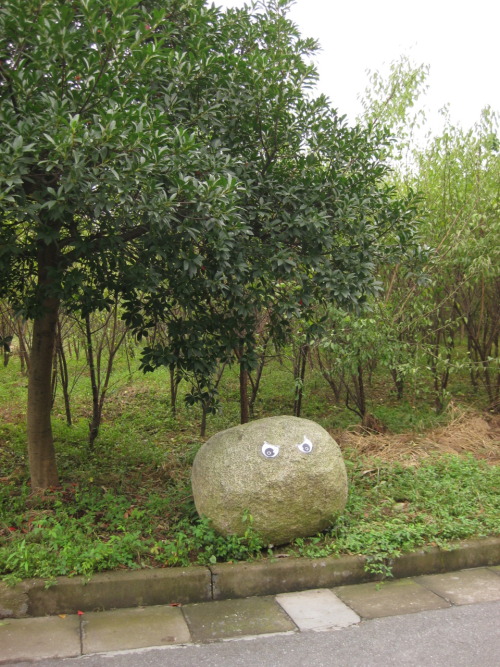
Hey you! Yeah, you.
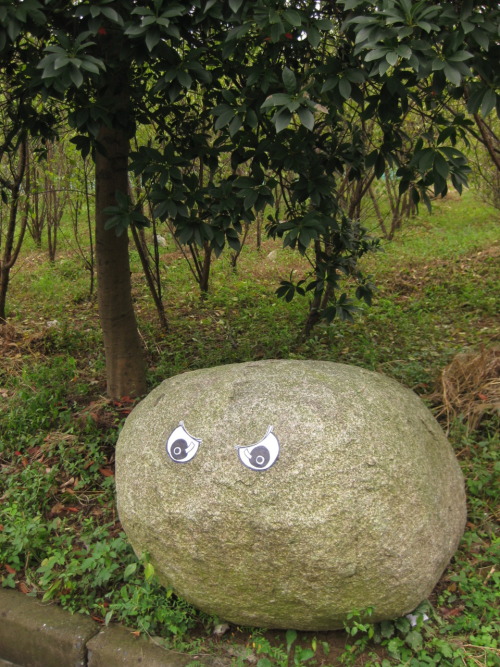
Get over here!
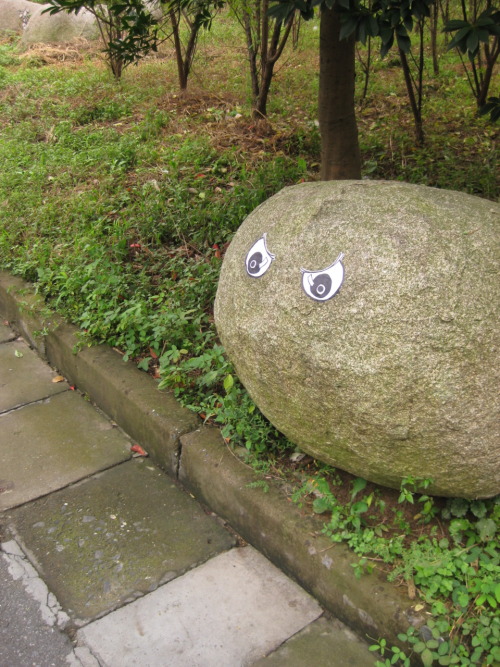
I want to have a word with you.
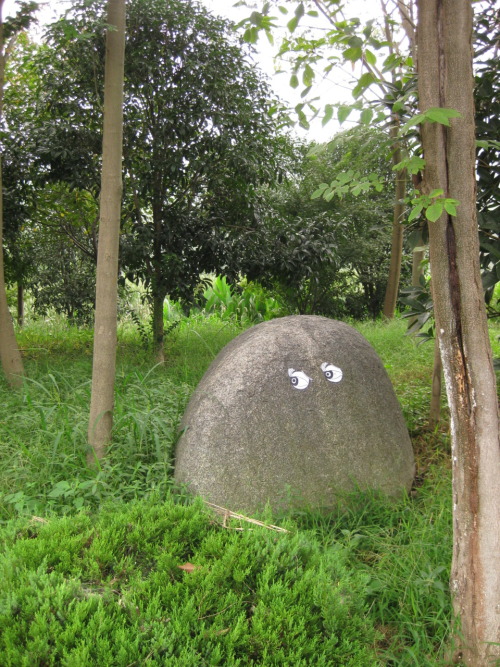
Oooh, you gonna get it now!
Angry rock by the side of the road wants to have a word with you.
Add a CommentBlog: MCFC Books (Login to Add to MyJacketFlap)
JacketFlap tags: art, graffiti, eyes, street art, QE, trash mouth, dustmen, Add a tag
Blog: MCFC Books (Login to Add to MyJacketFlap)
JacketFlap tags: china, art, graffiti, eyes, street art, wheatpaste, QE, trash mouth, dustmen, photo comic, Add a tag
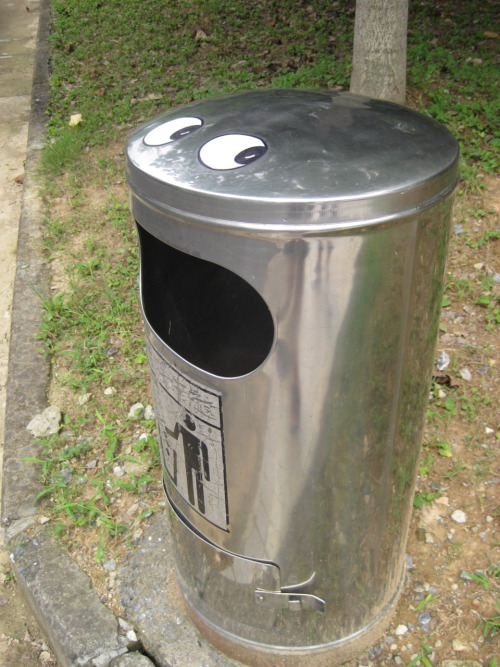
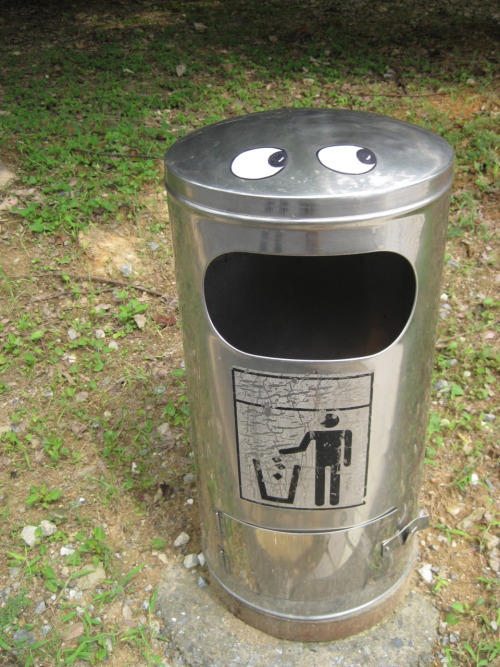
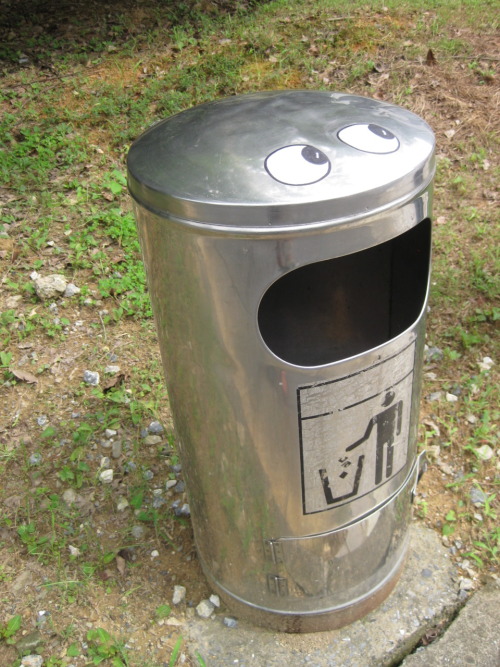
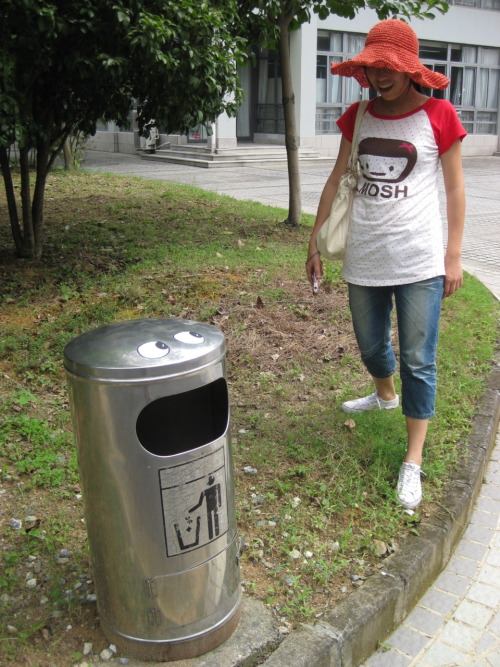
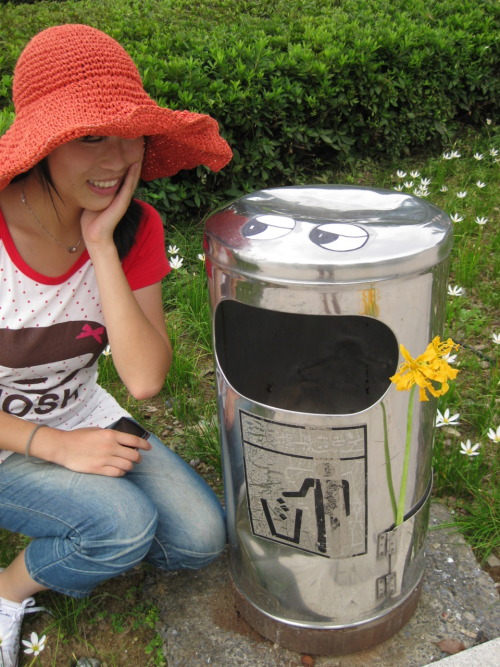
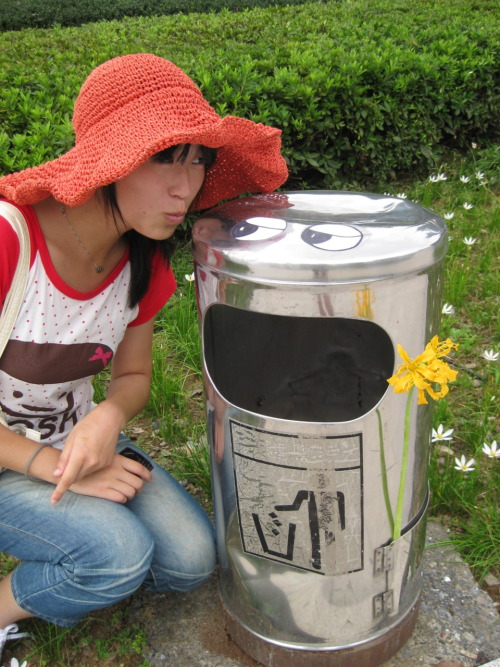
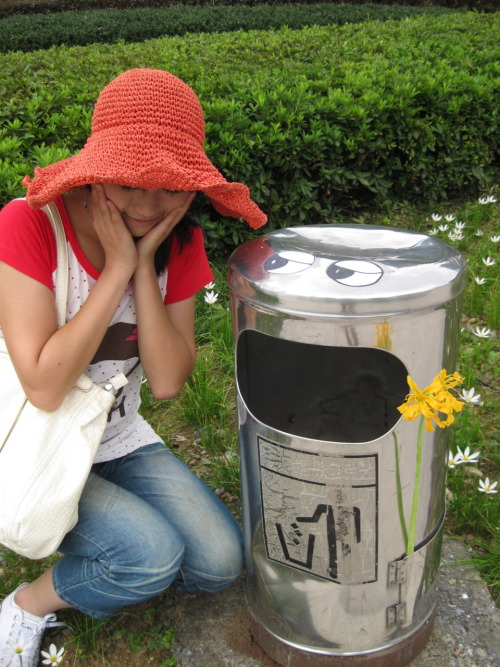
Photo Comic “Sunny meets the Dustmen”
Here, my friend Sunny runs into a couple of my Dustmen friends and romance blooms!
Add a CommentBlog: studio lolo (Login to Add to MyJacketFlap)
JacketFlap tags: studio lolo, laurel gaylord, animals, eyes, Add a tag
Display Comments Add a Comment
Blog: studio lolo (Login to Add to MyJacketFlap)
JacketFlap tags: eyes, studio lolo, laurel gaylord, Add a tag
Blog: the dust of everyday life (Login to Add to MyJacketFlap)
JacketFlap tags: eyes, guess who, costumes, silly, Add a tag
Blog: Shari Lyle-Soffe (Login to Add to MyJacketFlap)
JacketFlap tags: dog, Poodle, eyes, health care, Shih Tzu, veterinary, Lhasa Apso, Add a tag
We missed our precious Lhasa Apso/poodle, Toby, so much that we wanted another small dog to fill the hole in our lives. My husband spotted an ad in the paper for a free Shih Tzu. It was in our price range so we called the number. Sadly, the advertised dog was gone...but they did have another Shih Tzu they were considering giving up. We asked if we could see him and the owner offered to bring him by the house. She delivered a ragged, semi-clean dog of questionable health. His name was Dallas and he didn't move a muscle when I removed him from the owners arms. He was seven years old and very small...less than eight pounds. We said we would take him on the condition that he passed a Veterinary exam. The owner hesitated but then she agreed.
We took him into the Vet's office and quickly received the bad news, fleas, worms, tapeworm, malnourished, dehydrated, and a severe infection in both ears. In addition he had a heart murmur. I started to cry. Toby had a heart murmur and I couldn't face going through the expense and the sadness again. That was when the Vet said "This is abusive treatment, whatever you do, do not give this dog back to those people!" So there we stood, between a rock and a hard place. My husband and I looked at each other and we knew we couldn't turn back. Dallas was now our dog.
(The picture above is of Dallas. I apologize for the glowing eyes, they are actually black. I'm not a photographer.)
It is expensive to own a pet. Animals need health care just as people do, and if you can't afford to take care of a pet you shouldn't own one. They need regular exams and vaccinations, and treatment when they have health problems. Animals also have feelings, they are not like stuffed animals, they feel pain and fear. They deserve to be treated with respect.
I didn't like Dallas' name so I call him Dustbunny, although his name is still Dallas. He is a pretty quiet pet unless he wants something, then he becomes very vocal. He doesn't like to be left alone so he usually travels with us when we go to the coast for a few days. He travels well in the car and is good in the motel, but he llimits our ability to go into food establishments. We travel in warm weather so we pick places where we can eat outside...or occasionally in our car.
Shih Tzu's have bug eyes and they are very suseptible to injury. Sadly an accidental injury made it necessary to have Dallas's eye removed recently. He still gets around okay, but he looks a bit like a pirate.
We have had Dallas for three years and we were feeling that Amber and Dallas made for a good sized family...then it happened again.
To be continued...
Blog: Sugar Frosted Goodness (Login to Add to MyJacketFlap)
JacketFlap tags: linocut, eyes, baggelboy, Add a tag
Blog: Joe Silly Sottile's Blog (Login to Add to MyJacketFlap)
JacketFlap tags: movies, children's poetry, poems, goals, Rose, eyes, Hillary, surgery, everyday life, Morgan, souls, Invictus, Add a tag
 I think that’s a wild and crazy picture of Hillary, and I figured it was a good way to get your attention. I always loved the quote, “Our eyes are windows to our soul.” I heard that many moons ago, yet I think about it a lot as watch people come and go daily in my life. I am highly attracted to people who have a passion in their eyes that declare, “I love the work that I do! Just watch me do my thing!” Of course, I love observing them.
I think that’s a wild and crazy picture of Hillary, and I figured it was a good way to get your attention. I always loved the quote, “Our eyes are windows to our soul.” I heard that many moons ago, yet I think about it a lot as watch people come and go daily in my life. I am highly attracted to people who have a passion in their eyes that declare, “I love the work that I do! Just watch me do my thing!” Of course, I love observing them. Morgan shared a poem that meant a great deal to him that learned in his youth and is a pivotal part of his latest movie. Can you imagine that?—poetry being important in the mainstream? The movie? The movie is Invictus, starring Morgan as Nelson Mandela, who rallies South Aftrica’s underdog rugby team as they strive to do the impossible: win the 1995 World Cup Championship match. The movie is named after a poem. Can you believe that?
Charlie said at the end that there’s always a great story if you can get someone to talk about why they leap out of bed in the morning.
 In the morning, I leapt out of bed, even though I had a significantly less amount of sleep than usual, a
In the morning, I leapt out of bed, even though I had a significantly less amount of sleep than usual, a
Blog: OUPblog (Login to Add to MyJacketFlap)
JacketFlap tags: A-Featured, Medical Mondays, eyes, diabetes, cost, complication, ocular disease, Health, Add a tag

Diabetes mellitus is a complex, multifactorial disease that is often associated with progressive retinopathy and visual loss. In Diabetes and Ocular Disease: Past, Present, and Future Therapies, 2nd
edition, edited by Ingrid U. Scott, MD, MPH, Harry W. Flynn, Jr., MD, Dr. William E. Smiddy, MD, readers have a practical reference for the diagnosis and management of ocular disease in diabetic patients. In the excerpt below, from the opening essay by Robert E. Leonard II, MD, and David W. Parke II, MD, we learn about the consequences of diabetes.
Treatment of complications due to diabetes is a growing source of health care expenditures. While ophthalmologists focus on the retinal and ophthalmic complications of diabetes and their treatment costs, it is important to note that these represent only a fraction of the overall costs of uncontrolled diabetes. Chronic complications of diabetes include accelerated atherosclerosis and its associated macrovascular disease processes of CHD, stroke, and peripheral vascular disease. These are responsible for the majority of diabetes-associated morbidity and mortality. Peripheral and autonomic neuropathy, renal impairment and failure, and diabetic retinopathy are associated with the microvascular complications of diabetes. As an example, Haffner and colleagues compared the 7-year incidence of myocardial infarction (MI) in diabetic and nondiabetic subjects with and without prior CHD. Their data suggest that diabetic patients without a previous MI have a higher risk of MI than nondiabetic patients who have had a previous history of MI. Persons with diabetes have a nearly seven-fold increase in heart disease compared to nondiabetic patients. CHD is the number one cause of death in the developed world, and accounts for over 500,000 deaths per year in the United States alone. It is clear that the emerging diabetic epidemic facing the developing nations of the world will significantly change rates of CHD and associated mortality in coming years.
In the United States alone, the cost of treating uncomplicated diabetes is over 6 billion dollars per year. Acute complications of diabetes, such as emergent hypoglycemia or hyperglycemia, raise that cost significantly. The chronic complications of diabetes, as mentioned above, totaled over 44.1 billion dollars in 1997. That represented 10,071 dollars per each diabetic patient in the United States. The total cost related to diabetic complications in the United States is estimated to be at least 100 billion dollars per year…
Numerous studies have shown that the key to decreasing diabetic complications lies with strict glucose control. The Diabetic Control and Complications Trial (DCCT) has shown the benefits of intensive blood glucose control in patients with type 1 diabetes. Intensive glucose control reduced the risk of developing reti
Blog: Sugar Frosted Goodness (Login to Add to MyJacketFlap)
JacketFlap tags: bunny girl, bunnny, china ink, illustration, art, hair, sad, sorrow, Artwork, eyes, traditional, Anita Mejía, ribbon, chocolatita, inks, Add a tag
Blog: Monday Artday (Login to Add to MyJacketFlap)
JacketFlap tags: bunny girl, bunnny, china ink, illustration, art, hair, sad, sorrow, artwork, eyes, traditional, Anita Mejía, ribbon, chocolatita, inks, Add a tag
Blog: Sugar Frosted Goodness (Login to Add to MyJacketFlap)
JacketFlap tags: editorial illustration, eyes, digital illustration, Add a tag
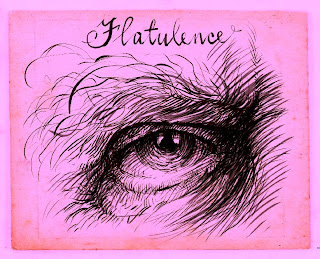
The dreaded Oink Eye.... erm Pink eye.
Blog: Yesisedit's Weblog (Login to Add to MyJacketFlap)
JacketFlap tags: Life, story, Photos, friends, Fun, love, Thoughts, Art, nature, Ideas, Color, Poem, Children's book, thought, sky, colorful, eyes, storm, Thank yous, Stories and art, Say it ain't so, 1, look, childrens poems, Fair-e-tale, Words can be funny, Hap Murphy, Add a tag
Blog: Saints and Spinners (Login to Add to MyJacketFlap)
JacketFlap tags: family, Lucia, eyes, Add a tag
My aunt sent me a video of a news segment that highlights my cousin, Dr. Monica Dweck, an opthalmologist who could work anywhere in the country but chooses to practice at Downstate Medical University in Brooklyn, New York, where she did her residency. Years ago, when Bede and I found out that our nine-month old daughter had a condition called Persistent Hyperplastic Primary Vitreous (PHPV), and
Blog: OUPblog (Login to Add to MyJacketFlap)
JacketFlap tags: oxford, challenged, A-Featured, Lexicography, word, ben, Dictionaries, chic, definition, corpus, zimmer, From A To Zimmer, creative, phrasal, rage, wordspy, geek, rages, phrase, variation, Add a tag
Erin McKean, who is OUP’s chief consulting editor for American dictionaries when she’s not busy being “America’s lexicographical sweetheart,” filled in this past Sunday for a vacationing William Safire, devoting the New York Times Magazine’s “On Language” column to a subject that should be familiar to readers of this column: the Oxford English Corpus and the fascinating things that it tells us about our changing language. (more…)




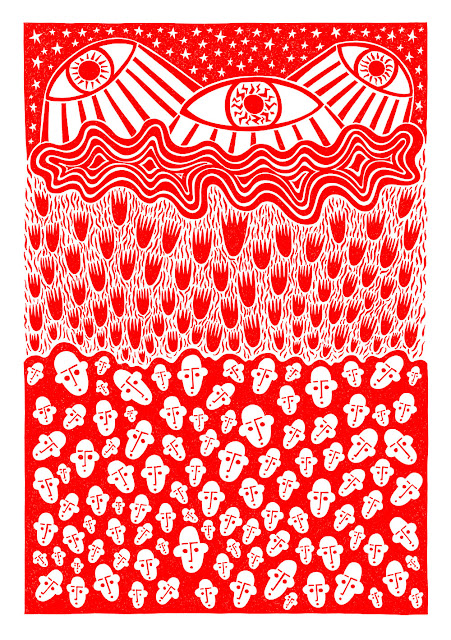



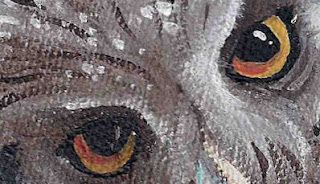

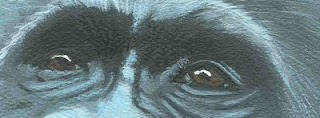
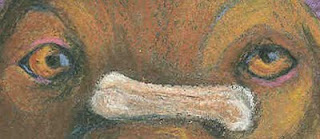
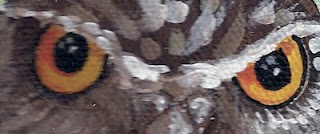

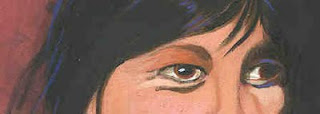


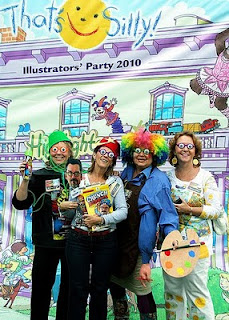







The book cover looks scary - definitely one that most boys would pull out from the shelves. I'm glad to hear that even the adults were having fun with the book. Will check it out.
what a great idea for a book... here's lookin' at you, kid.